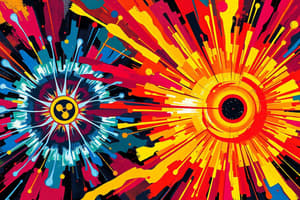Podcast
Questions and Answers
What is the mechanism behind the formation of nuclear cataract?
What is the mechanism behind the formation of nuclear cataract?
Deamidation of lens proteins by oxidation, proteolysis and glycation.
What does nuclear cataract appear like on an oblique slit lamp beam?
What does nuclear cataract appear like on an oblique slit lamp beam?
Central region of the lens acquires a murky, yellowish to brunescent appearance.
What does cortical cataract appear like on an oblique slit lamp beam?
What does cortical cataract appear like on an oblique slit lamp beam?
Wedges and lamellar separations.
What is the mechanism behind cortical cataract?
What is the mechanism behind cortical cataract?
What is the mechanism behind age-related posterior subcapsular cataract?
What is the mechanism behind age-related posterior subcapsular cataract?
What does posterior subcapsular cataract look like on an oblique slit lamp beam?
What does posterior subcapsular cataract look like on an oblique slit lamp beam?
What does posterior subcapsular cataract look like on retro illumination?
What does posterior subcapsular cataract look like on retro illumination?
What is the presentation of anterior polar cataract?
What is the presentation of anterior polar cataract?
What is the prognosis of anterior polar cataract?
What is the prognosis of anterior polar cataract?
What is the prognosis of posterior polar cataract?
What is the prognosis of posterior polar cataract?
Where does posterior polar cataract often arise from?
Where does posterior polar cataract often arise from?
What should be considered when operating on posterior polar cataract?
What should be considered when operating on posterior polar cataract?
What are the common causes of posterior subcapsular cataract?
What are the common causes of posterior subcapsular cataract?
What is the prognosis of posterior subcapsular cataract?
What is the prognosis of posterior subcapsular cataract?
What characterizes diffuse/total cataract?
What characterizes diffuse/total cataract?
What is involved in the grading of nuclear sclerotic cataracts?
What is involved in the grading of nuclear sclerotic cataracts?
How is cortical cataract grading measured?
How is cortical cataract grading measured?
How is the grading of posterior subcapsular cataracts measured?
How is the grading of posterior subcapsular cataracts measured?
What is an immature cataract?
What is an immature cataract?
What characterizes intumescent cataract?
What characterizes intumescent cataract?
What characterizes hypermature cataract?
What characterizes hypermature cataract?
What is Morganian cataract characterized by?
What is Morganian cataract characterized by?
Flashcards are hidden until you start studying
Study Notes
Nuclear Cataract
- Formation involves deamidation of lens proteins, oxidation, proteolysis, and glycation.
- Presents with myopic shift and a murky, yellowish to brunescent appearance in the central lens region.
Cortical Cataract
- Identified by wedge-shaped opacities and lamellar separations on oblique slit lamp examination.
- Caused by electrolyte imbalance, leading to lens overhydration and liquefaction, contributing to glare.
Posterior Subcapsular Cataract
- Characterized by loss of lens fiber nuclei and migration of epithelial cells towards the posterior pole.
- Appears lacy and granular under oblique slit lamp; shows black, vaculated features on retro illumination.
- Develops idiopathically, from radiation, trauma, chronic steroid use, or after pars plana vitrectomy.
Anterior Polar Cataract
- Presents as 1-2 mm white opacity in the central anterior lens capsule, often bilateral and present at birth.
- Typically does not require surgery; associated with astigmatism, necessitating monitoring and refractive correction.
Prognosis
- Posterior polar cataracts are visually significant and progress rapidly, often necessitating surgical interventions like posterior capsulotomy.
- Anterior polar cataracts are stable and usually manageable without surgery.
Cataract Classification
- Total cataract features complete opacification of both nucleus and cortex, marking end-stage partial cataracts.
- Immature cataracts exhibit lens changes that are not visually incapacitating.
- Intumescent cataracts are mature yet swollen and may cause secondary angle-closure.
- Hypermature cataracts show lens shrinkage and wrinkled capsule, while Morganian cataracts involve liquefaction of cortical contents, leaving a hard nucleus within the capsule.
Grading of Cataracts
- Nuclear sclerotic cataracts are graded by assessing the average color and opalescence of the nucleus.
- Cortical cataracts are graded based on the percentage of the intrapupillary space occupied by opacity.
- Posterior subcapsular cataracts are graded by evaluating the percentage of the posterior capsule area affected by opacity.
Studying That Suits You
Use AI to generate personalized quizzes and flashcards to suit your learning preferences.




